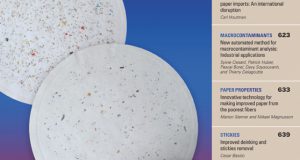THE PAPERS SUMMARIZED HERE are from the June 2016 issue of TAPPI Journal featuring special nanotechnology content, along with the July 2016 issue featuring special content from the 2015 PEERS Conference. TAPPI Journal is an online publication of relevant and timely peer-reviewed research delivered via email and free to all TAPPI members. To receive TAPPI Journal, join TAPPI at www.tappi.org.
JUNE
CELLULOSE NANOCRYSTALS
Critical discussion on the thermal behavior of sulfated cellulose nanocrystals
Gregory Chauve, Damien Mauran, Carole Fraschini, and
Jean Bouchard
 Cellulose nanocrystals (CNCs) have evolved from a laboratory curiosity to an industrial material manufactured at a scale of up to 1 ton/day. In order to maximize their use in various applications such as composites, it is critical to evaluate the influence of the surface chemistry on their thermal stability. Temperature is heavily damaging to the material integrity of native CNCs, but the early stage temperature-catalyzed degradation process can be prevented by neutralization of the surface sulfate half-ester groups, either by organic or inorganic counterions. In addition, the researchers studied the influence of the hydrolysis conditions on the CNCs’ resistance to elevated temperatures. The observations were carried out by thermogravimetric analysis (TGA). Finally, we present complementary work regarding color formation when CNCs are exposed to heat.
Cellulose nanocrystals (CNCs) have evolved from a laboratory curiosity to an industrial material manufactured at a scale of up to 1 ton/day. In order to maximize their use in various applications such as composites, it is critical to evaluate the influence of the surface chemistry on their thermal stability. Temperature is heavily damaging to the material integrity of native CNCs, but the early stage temperature-catalyzed degradation process can be prevented by neutralization of the surface sulfate half-ester groups, either by organic or inorganic counterions. In addition, the researchers studied the influence of the hydrolysis conditions on the CNCs’ resistance to elevated temperatures. The observations were carried out by thermogravimetric analysis (TGA). Finally, we present complementary work regarding color formation when CNCs are exposed to heat.
Our aim was to combine various approaches and propose a method for the determination of precise and accurate values of thermal stability when working with cellulosic nanocrystals.
MICROFIBRILLATED CELLULOSE
A comparative study of enzymatic and Fenton pretreatment applied to a birch kraft pulp used for MFC production in a pilot scale high-pressure homogenizer
Pia Hellström, Anette Heijnesson-Hultén, Magnus Paulsson, Helena Håkansson, and Ulf Germgård
Microfibrillated cellulose (MFC) was produced in pilot scale from a bleached birch (Betula verrucosa) kraft pulp that was pretreated with either Fenton’s reagent or with a combined mechanical and enzymatic method used at the  Centre Technique du Papier (CTP). Researchers then monitored the change in fiber fibrillation during the homogenization treatment.
Centre Technique du Papier (CTP). Researchers then monitored the change in fiber fibrillation during the homogenization treatment.
The Fenton pretreatment resulted in MFC suspensions that contained a high amount of small sized elements. After five passes through the high-pressure homogenizer, the amount of particles smaller than 20 µm was 37 percent for the Fenton pretreated MFC compared to 13 percent for the enzymatically (endoglucanase) pretreated MFC. Altogether, the Fenton pretreatment enabled preparation of MFC with a higher degree of fibrillation after the same number of passes through the high-pressure homogenizer. Another option is to produce MFC of the same amount of fibrillation as after an enzymatic stage, but at significantly lower energy consumption.
Fenton pretreatment may be used as an alternative to enzymatic hydrolysis in the production of MFC and give an opportunity to further reduce the energy demand or produce a product with higher amount of small sized elements.
Scanning electron microscope images of enzyme (A) and Fenton (B) pretreated birch kraft pulp after five passes through the high-pressure homogenizer.
MICRO & NANOFIBRILLATED CELLULOSE
Rheological investigation of complex micro and nanofibrillated cellulose (MNFC) suspensions:
Discussion of flow curves and gel stability
Michel Schenker, Joachim Schoelkopf, Patrice Mangin, and Patrick Gane
 Micro and nanofibrillated cellulose in aqueous suspension presents many challenges when considering its use in forming nanocomposites. The inclusion of filler particles either as extender or as functional additive allows the range of strength and deformation properties to be extended. These properties, however, are linked in many cases to the rheological properties of the raw material mix. Interactions under dynamic shear or under controlled stress at low amplitude reveal the potential to generate functional interactions, not only between the cellulose components themselves, but also between the cellulose and polymer additives, as well as surface-modified pigment fillers.
Micro and nanofibrillated cellulose in aqueous suspension presents many challenges when considering its use in forming nanocomposites. The inclusion of filler particles either as extender or as functional additive allows the range of strength and deformation properties to be extended. These properties, however, are linked in many cases to the rheological properties of the raw material mix. Interactions under dynamic shear or under controlled stress at low amplitude reveal the potential to generate functional interactions, not only between the cellulose components themselves, but also between the cellulose and polymer additives, as well as surface-modified pigment fillers.
This research confirms findings of others in respect to the influence of additives like polyelectrolytes and pigment particles on MNFC suspension rheology. However, previously unreported effects are described for polyelectrolyte treated pigment particles, indicating an increased interaction with MNFC to the advantage of future products, such as fibrillar-based nanocomposites.
Proposed conformations for MNFC suspensions with and without CMC and/or pigment. Blue halos around fibers indicate their interaction potential; red halos indicate altering of the fiber-fiber interaction potential related to CMC presence.
CELLULOSE NANOFIBRILS
Effects of mechanical fibrillation time by disk grinding on the properties of cellulose nanofibrils
Qianqian Wang and J.Y. Zhu
Cellulose nanofibrils (CNF) were successfully produced from a bleach kraft eucalyptus pulp by a supermasscolloider. Effects of grinding time on structure and properties of CNF and the corresponding CNF films were investigated.  Grinding time was important to increase the optical transparency of CNF suspensions. The degree of polymerization (DP) and crystallinity index (CrI) of CNF decreased linearly with the increase in CNF suspension transparency. This suggests optical transparency of a CNF suspension can be used to characterize the degree of fibrillation. Specific tensile strength and Young’s modulus of the CNF films made of CNF suspension with only 0.5 h grinding were increased approximately 30 percent and 200 percent, respectively, compared with conventional handsheets prepared by valley beating to 300 CSF. Grinding beyond 0.5 h produced negligible improvement in specific tensile and specific modulus. Opacity of CNF films decreased rapidly during the first 1.5 h of fibrillation and then plateaued.
Grinding time was important to increase the optical transparency of CNF suspensions. The degree of polymerization (DP) and crystallinity index (CrI) of CNF decreased linearly with the increase in CNF suspension transparency. This suggests optical transparency of a CNF suspension can be used to characterize the degree of fibrillation. Specific tensile strength and Young’s modulus of the CNF films made of CNF suspension with only 0.5 h grinding were increased approximately 30 percent and 200 percent, respectively, compared with conventional handsheets prepared by valley beating to 300 CSF. Grinding beyond 0.5 h produced negligible improvement in specific tensile and specific modulus. Opacity of CNF films decreased rapidly during the first 1.5 h of fibrillation and then plateaued.
This research indicates that disk milling time affects the morphology of cellulose nanofibrils as well as the optical and mechanical properties of film made of the resultant fibrils.
JULY
PROCESS CONTROL
Commissioning brownstock washing controls for an evaporator limited mill
Ricardo B. Santos and Peter W. Hart
An automated shower water control system has been implemented to reduce the volume and variability of weak black liquor being sent from the pulp mill to the evaporators. The washing controls attempt to balance the need for consistent and low soda carryover to the bleach plant with consistently high weak black liquor solids being sent to the evaporators.
The washer controls were implemented on two bleachable grade hardwood lines (one with oxygen delignification, one without oxygen delignification) and one pine line. Implementation of the control program resulted in an increase in black liquor solids of 0.6 percentage points for the hardwood lines. Significant foam reduction was realized on the pine line since the pine black liquor solids were able to be consistently maintained just below the soap separation point.
This information can be used by kraft mills around the world. The researchers have provided an easy approach to control brownstock washing and maximize pulp production by avoiding evaporator capacity reduction.
RECOVERY CYCLE
Effects of added materials on black liquor combustion
Liming Zhao, Danielly Cortes, and Honghi Tran
 Black liquor is often mixed with various types of materials before being burned in a recovery boiler to meet specific needs of kraft pulp mills. In a systematic study, researchers used a thermogravimetric combustor to examine how added materials might affect the combustion behavior of black liquors obtained from several pulp mills. The results show that adding soap, caustic, white liquor, and sawdust significantly reduces the liquor swelling tendency, thereby requiring a longer time for the liquor to burn completely. Adding makeup saltcake, precipitator ash, sodium sulfate, and biosludge, on the other hand, has little or no effect on the liquor combustion behavior.
Black liquor is often mixed with various types of materials before being burned in a recovery boiler to meet specific needs of kraft pulp mills. In a systematic study, researchers used a thermogravimetric combustor to examine how added materials might affect the combustion behavior of black liquors obtained from several pulp mills. The results show that adding soap, caustic, white liquor, and sawdust significantly reduces the liquor swelling tendency, thereby requiring a longer time for the liquor to burn completely. Adding makeup saltcake, precipitator ash, sodium sulfate, and biosludge, on the other hand, has little or no effect on the liquor combustion behavior.
Mills that understand how each added material affects the combustion behavior of black liquor can optimize their recovery boiler operation.
BIOREFINERY
Estimation of the S/G ratios of the lignins in three widely used North American hardwoods
Dan J. Nicholson, Candace R. Guilford, Adebukola B. Abiola, Samar K. Bose, and Raymond C. Francis
Sugar maple, aspen, and white birch are three hardwoods widely used by the North American pulp and paper industry. Because of their abundance, these species are also likely to be used by some biorefinery processes being developed. A significant amount of evidence indicates that the syringyl to guaiacyl (S/G) ratio of the lignin in a hardwood is a governing parameter regarding its ease of delignification. Credible data also show that, among poplars, the S/G ratio of the lignin significantly influences the ease of saccharification of the carbohydrate polymers to sugar monomers. Although the S/G ratio appears to be a key parameter for hardwoods, values accepted by most  practitioners are not available for the three species.
practitioners are not available for the three species.
In this investigation, those ratios were estimated by an extensive literature review followed by S/G determination by nitrobenzene oxidation (NBO) and methoxyl analyses of organosolv lignin (OSL) from the ethanol/water/sulfuric acid pulping process. The S/G values were approximately 1.4 for sugar maple, and 2.0 for aspen and white birch. Data are also included showing that sugar maple and white birch were equally reactive in kraft pulping. Thus, it is unclear whether or not the S/G ratio is indeed a governing parameter in this delignification process.
These results suggest that S/G ratio alone cannot explain the different rates of delignification by kraft liquor typically observed among hardwoods. Mills might benefit from including more sugar maple in their cooking furnish, if possible.
CNC discoloration from heat exposure is of concern due to undesirable appearance of natural-fiber reinforced polymer end product.
Impacts of fibrillation time on CNF films’ optical and strength properties.
Main products from nitrobenzene oxidation of hardwood lignins.
Thermogravimetric combustor used in the black liquor combustion research.
OTHER RESEARCH APPEARING IN TAPPI Journal’s JUNE 2016 ISSUE:
CELLULOSE NANOCRYSTALS
Ionic strength control of sulfated cellulose nanocrystal suspension viscosity
Stephanie Beck and Jean Bouchard
PAPERMAKING
Effects of cellulosic nanofibrils on papermaking properties of fine papers
Donna A. Johnson, Mark A. Paradis, Michael Bilodeau, Bruce Crossley, Marc Foulger, and Pierre Gélinas
HEALTH & SAFETY
Toward cellulose nanomaterial commercialization: Knowledge gap analysis for Safety Data Sheets according to the Globally Harmonized System
Jo Anne Shatkin, Kimberly J. Ong, James D. Ede, Theodore H. Wegner, and Michael Goergen
OTHER RESEARCH APPEARING IN TAPPI Journal’s JULY 2016 ISSUE:
CORROSION & MATERIALS
Evaluation of near-drum thinning data in recovery boiler generating bank tubes
W.B.A (Sandy) Sharp and W.A. (Billy) Jones
CORROSION & MATERIALS
Corrosion monitoring and root cause identification in high solids concentrators
Pasi Niemeläinen
 Paper 360
Paper 360


